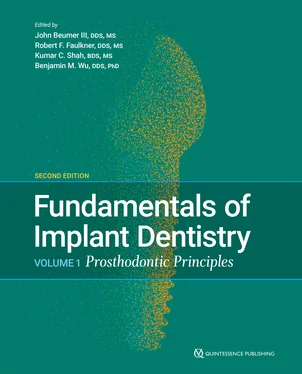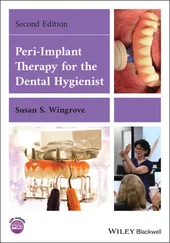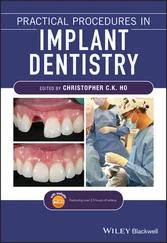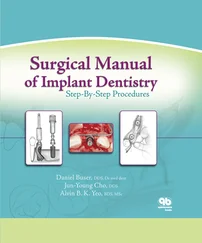Because the accuracy of guided implant placement largely depends on the quality of the CBCT image, the radiographic image should be obtained with minimal errors. If the patient has a significant amount of metal present in the mouth, heavy scattering within the CBCT image may occur (see Fig 5-9); hence, the patient may be required to wear a specific radiographic template during the CBCT scan to minimize artifacts in the segmented model. In addition, properly positioning the patient and ensuring that the patient is stable during the scan are especially important to eliminate the need to guess the desired outcomes.
Ultimately, the clinician is responsible for making an accurate diagnosis and carefully evaluating the needs of the patient and implant team when deciding to use digital treatment planning. The clinician may experience access difficulties while drilling and placing the posterior implants through the guide. This is more prominent for patients with limited mouth opening. In addition, long sleeves may interfere with the irrigation and cooling of the osteotomy drills. Poorly designed implant guides may have thin sections that can break during surgery. While the guided implant surgery is more accurate and reliable than conventional implant placement, it is still associated with errors. Studies have indicated the deviation of a placed implant compared to planned implant placement is within 1 to 2 mm in the horizontal dimension 105, 112and 5 to 10 degrees in angle orientation. 103, 113As result, it is crucial for the clinician to appreciate that these technologies, while beneficial, do not replace traditional surgical skills and pros- thodontic design fundamentals.
References
1.Abduo J, Lyons K. Rationale for the use of CAD/CAM technology in implant prosthodontics. Int J Dent 2013;2013:768121.
2.Kapos T, Evans C. CAD/CAM technology for implant abutments, crowns, and superstructures. Int J Oral Maxillofac Implants 2014;29 (suppl):117–136.
3.Wismeijer D, Brägger U, Evans C, et al. Consensus statements and recommended clinical procedures regarding restorative materials and techniques for implant dentistry. Int J Oral Maxillofac Implants 2014;29(suppl):137–140.
4.Fortin T, Isidori M, Bouchet H. Placement of posterior maxillary implants in partially edentulous patients with severe bone deficiency using CAD/CAM guidance to avoid sinus grafting: A clinical report of procedure. Int J Oral Maxillofac Implants 2009;24:96–102.
5.An X, Fang JH, Jeong SM, Choi BH. A CAD-CAM technique for conversion of interim-to-definitive restoration in patients with complete edentulism. J Prosthet Dent 2018;120:190–193.
6.Joda T, Brägger U. Digital vs. conventional implant prosthetic workflows: A cost/time analysis. Clin Oral Implants Res 2015;26:1430–1435.
7.Papaspyridakos P, Rajput N, Kudara Y, Weber HP. Digital workflow for fixed implant rehabilitation of an extremely atrophic edentulous mandible in three appointments. J Esthet Restor Dent 2017;29:178–188.
8.Bukhari S, Goodacre BJ, AlHelal A, Kattadiyil MT, Richardson PM. Three-dimensional printing in contemporary fixed prosthodontics: A technique article. J Prosthet Dent 2018;119:530–534.
9.Papaspyridakos P, Kang K, DeFuria C, Amin S, Kudara Y, Weber HP. Digital workflow in full-arch implant rehabilitation with segmented minimally veneered monolithic zirconia fixed dental prostheses: 2-year clinical follow-up. J Esthet Restor Dent 2018;30:5–13.
10.Cassetta M, Stefanelli LV, Giansanti M, Calasso S. Accuracy of implant placement with a stereolithographic surgical template. Int J Oral Maxillofac Implants 2012;27:655–663.
11.Farley NE, Kennedy K, McGlumphy EA, Clelland NL. Split-mouth comparison of the accuracy of computer-generated and conventional surgical guides. Int J Oral Maxillofac Implants 2013;28:563–572.
12.Vieira DM, Sotto-Maior BS, Barros CA, Reis ES, Francischone CE. Clinical accuracy of flapless computer-guided surgery for implant placement in edentulous arches. Int J Oral Maxillofac Implants 2013;28:1347–1351.
13.Beuer F, Schweiger J, Edelhoff D. Digital dentistry: An overview of recent developments for CAD/CAM generated restorations. Br Dent J 2008;204:505–511.
14.Miyazaki T, Hotta Y. CAD/CAM systems available for the fabrication of crown and bridge restorations. Aust Dent J 2011;56(1 suppl):97–106.
15.Abduo J, Lyons K, Bennamoun M. Trends in computer-aided manufacturing in prosthodontics: A review of the available streams. Int J Dent 2014;2014:783948.
16.Örtorp A, Jemt T, Bäck T, Jälevik T. Comparisons of precision of fit between cast and CNC-milled titanium implant frameworks for the edentulous mandible. Int J Prosthodont 2003;16:194–200.
17.Örtorp A, Jemt T. CNC-milled titanium frameworks supported by implants in the edentulous jaw: A 10-year comparative clinical study. Clin Implant Dent Relat Res 2012;14:88–99.
18.Abduo J, Lyons K, Bennani V, Waddell N, Swain M. Fit of screw- retained fixed implant frameworks fabricated by different methods: A systematic review. Int J Prosthodont 2011;24:207–220.
19.Denry I, Kelly JR. State of the art of zirconia for dental applications. Dent Mater 2008;24:299–307.
20.Young JM, Altschuler BR. Laser holography in dentistry. J Prosthet Dent 1977;38:216–225.
21.Mörmann WH. The evolution of the CEREC system. J Am Dent Assoc 2006;137:7S–13S.
22.Mörmann WH, Brandestini M. The fundamental inventive principles of CEREC CAD/CAM. In: Mörmann WH (ed). State of the Art of CAD/CAM Restorations: 20 Years of CEREC. London: Quintessence, 2006:1–8.
23.Moy PK, Pozzi A, Beumer J 3rd (eds). Fundamentals of Implant Dentistry. Vol 2: Surgical Principles. Chicago: Quintessence, 2016.
24.Scarfe WC, Farman AG. What is cone-beam CT and how does it work? Dent Clin North Am 2008;52:707–730.
25.Logozzo S, Zanetti EM, Franceschini G, Kilpela A. Recent advances in dental optics—Part I: 3D intraoral scanners for restorative dentistry. Opt Lasers Eng 2014;54:203–221.
26.Duret F. Toward a new symbolism in the fabrication of prosthetic design [in French]. Cah Prothèse 1985;13:65–71.
27.Duret F, Preston JD. CAD/CAM imaging in dentistry. Curr Opin Dent 1991;1:150–154.
28.Frigerio F. 3-dimensional surface imaging using active wavefront samplin [thesis]. Cambridge, MA: Massachusetts Institute of Technology, 2006.
29.Kim SY, Kim MJ, Han JS, Yeo IS, Lim YJ, Kwon HB. Accuracy of dies captured by an intraoral digital impression system using parallel confocal imaging. Int J Prosthodont 2013;26:161–163.
30.Schmitt JM. Optical coherence tomography (OCT): A review. IEEE J Sel Top Quantum Electron. 1999;5:1205–1215.
31.Bonnema GT, Quadling HS, Quadling MS, inventors; D4D Technologies LP, assignee. Swept source optical coherence tomography (OCT) method and system. United States patent US 8,345,257. 1 Jan 2013.
32.de Boer JF, Leitgeb R, Wojtkowski M. Twenty-five years of optical coherence tomography: The paradigm shift in sensitivity and speed provided by Fourier domain OCT. Biomed Opt Express 2017;8:3248–3280.
33.Kim RJ, Park JM, Shim JS. Accuracy of 9 intraoral scanners for complete-arch image acquisition: A qualitative and quantitative evaluation.J Prosthet Dent 2018;120:895–903.
34.ISO. 5725-1: Accuracy (trueness and precision) of measurement methods and results—Part 1: General principles and definitions. Geneva: International Organization for Standardization, 1994.
35.Ender A, Attin T, Mehl A. In vivo precision of conventional and digital methods of obtaining complete-arch dental impressions. J Prosthet Dent 2016;115:313–20.
36.Imburgia M, Logozzo S, Hauschild U, Veronesi G, Mangano C, Mangano FG. Accuracy of four intraoral scanners in oral implant- ology: A comparative in vitro study. BMC Oral Health 2017;17:92.
37.Luz PB, Stringhini CH, Otto BR. Performance of undergraduate dental students on icdas clinical caries detection after different learning strategies. Eur J Dent Educ 2015;19:235–241.
Читать дальше












